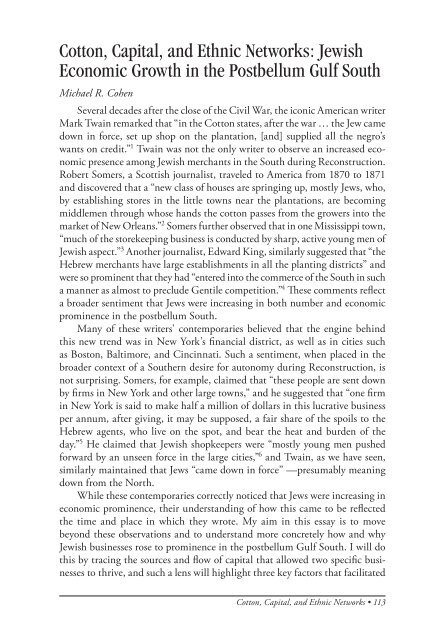American Jewish Archives Journal, Volume 64, Numbers 1 & 2
American Jewish Archives Journal, Volume 64, Numbers 1 & 2
American Jewish Archives Journal, Volume 64, Numbers 1 & 2
You also want an ePaper? Increase the reach of your titles
YUMPU automatically turns print PDFs into web optimized ePapers that Google loves.
Cotton, Capital, and Ethnic Networks: <strong>Jewish</strong><br />
Economic Growth in the Postbellum Gulf South<br />
Michael R. Cohen<br />
Several decades after the close of the Civil War, the iconic <strong>American</strong> writer<br />
Mark Twain remarked that “in the Cotton states, after the war … the Jew came<br />
down in force, set up shop on the plantation, [and] supplied all the negro’s<br />
wants on credit.” 1 Twain was not the only writer to observe an increased economic<br />
presence among <strong>Jewish</strong> merchants in the South during Reconstruction.<br />
Robert Somers, a Scottish journalist, traveled to America from 1870 to 1871<br />
and discovered that a “new class of houses are springing up, mostly Jews, who,<br />
by establishing stores in the little towns near the plantations, are becoming<br />
middlemen through whose hands the cotton passes from the growers into the<br />
market of New Orleans.” 2 Somers further observed that in one Mississippi town,<br />
“much of the storekeeping business is conducted by sharp, active young men of<br />
<strong>Jewish</strong> aspect.” 3 Another journalist, Edward King, similarly suggested that “the<br />
Hebrew merchants have large establishments in all the planting districts” and<br />
were so prominent that they had “entered into the commerce of the South in such<br />
a manner as almost to preclude Gentile competition.” 4 These comments reflect<br />
a broader sentiment that Jews were increasing in both number and economic<br />
prominence in the postbellum South.<br />
Many of these writers’ contemporaries believed that the engine behind<br />
this new trend was in New York’s financial district, as well as in cities such<br />
as Boston, Baltimore, and Cincinnati. Such a sentiment, when placed in the<br />
broader context of a Southern desire for autonomy during Reconstruction, is<br />
not surprising. Somers, for example, claimed that “these people are sent down<br />
by firms in New York and other large towns,” and he suggested that “one firm<br />
in New York is said to make half a million of dollars in this lucrative business<br />
per annum, after giving, it may be supposed, a fair share of the spoils to the<br />
Hebrew agents, who live on the spot, and bear the heat and burden of the<br />
day.” 5 He claimed that <strong>Jewish</strong> shopkeepers were “mostly young men pushed<br />
forward by an unseen force in the large cities,” 6 and Twain, as we have seen,<br />
similarly maintained that Jews “came down in force” —presumably meaning<br />
down from the North.<br />
While these contemporaries correctly noticed that Jews were increasing in<br />
economic prominence, their understanding of how this came to be reflected<br />
the time and place in which they wrote. My aim in this essay is to move<br />
beyond these observations and to understand more concretely how and why<br />
<strong>Jewish</strong> businesses rose to prominence in the postbellum Gulf South. I will do<br />
this by tracing the sources and flow of capital that allowed two specific businesses<br />
to thrive, and such a lens will highlight three key factors that facilitated<br />
Cotton, Capital, and Ethnic Networks • 113
















